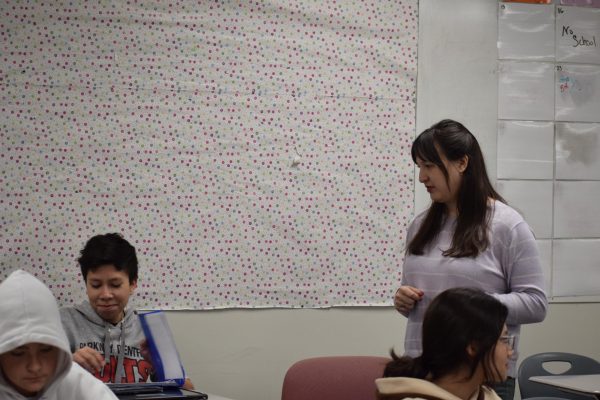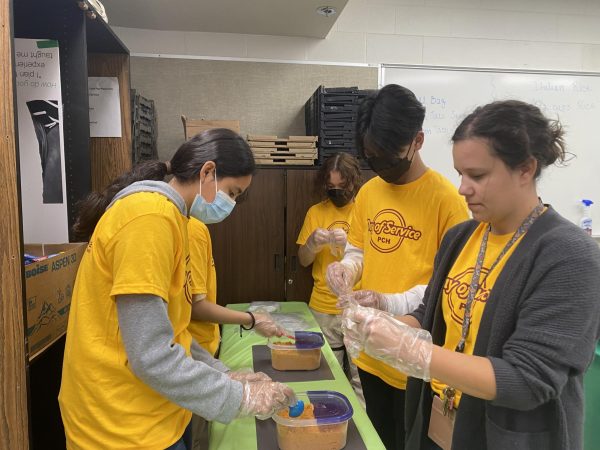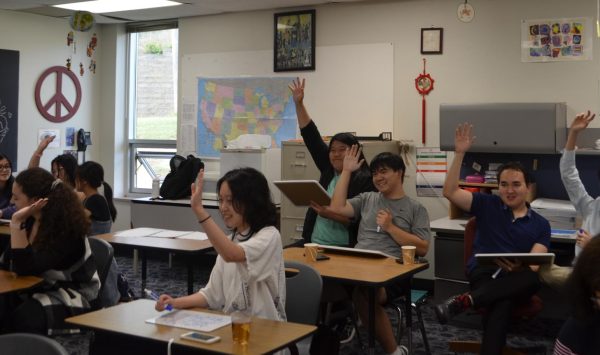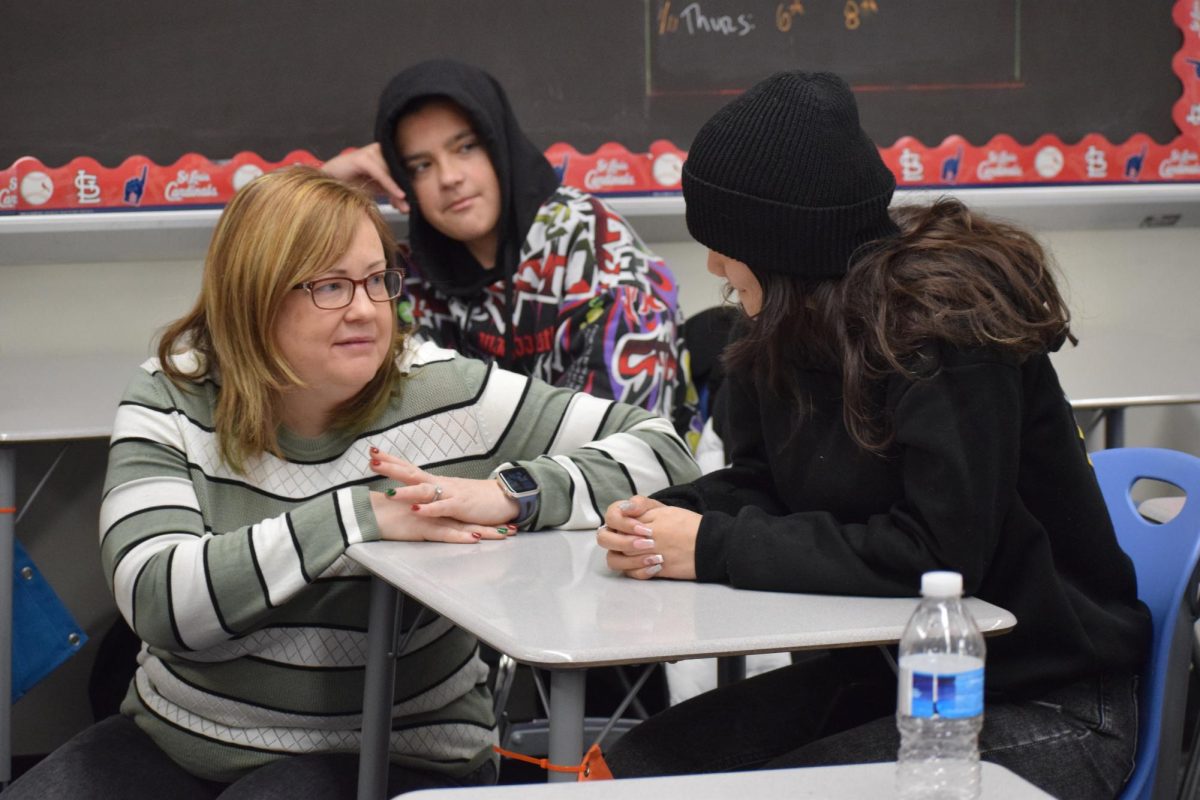The ESOL, or English Speakers of Other Languages department at PCH serves to help students who have immigrated here from other countries to learn English as well as acclimate to their new environment. ESOL also is referred to as ELL or EL.
“We provide a safe and encouraging learning environment for our students who are new to the English language, so they can not only learn English, but also learn and pass all of their content courses,” EL Teacher Kathryn Ott said.
When you move to another country, language isn’t the only thing you need to learn. ESOL students also have to juggle learning how the American school system, healthcare, finance, and other important systems in the U.S work. EL teachers have to teach students all of this important information as well.
“Part of what we do here is that we have to get them to understand how American education works. We’re figuring out credits, and writing letters of recommendations for college, and more,” ESOL Department Head Stacy Henry said.
To adjust to the American education system, the students have to not only learn English at a conversational level but at an educational level. They have to understand different content areas, such as math, science, and history, but in English, instead of their first languages.
Senior Nicole DeAraujo explains how her teachers helped her learn English.
“She teaches us words every week, so we can make our vocabulary bigger and these are words that we are gonna use in other classes,” DeAraujo said. “It really makes us learn other words, so I can talk with everybody.”
The ELL classes operate differently than most classes do, because they have a different style of teaching, often relying on graphic organizers and simplified language to teach content. However, the content is still the same.
“It’s the same curriculum, but we just teach it differently, so everyone can understand,” Ott said, “Like my Level fours, we are doing The Great Gatsby, but just how I’m teaching it is different.”
Along with language development classes, where students learn English, ELL students also have sheltered content area classes. This is where an ELL specialist and a content area teacher, like a math teacher or a science teacher, teach students together.
“The sheltered program is where you have a content area teacher and an ESOL specialist in the classroom together,” ELL Teacher Erin Rauch said. “The goal is for the ELL specialists to work with the content teacher to deliver the same curriculum, but using English language learning strategies, which means a lot more pictures, simplify the language, and a lot more like graphic organizers.”
The sheltered programming is one amongst many of the factors that make our school’s ELL department unique. Central is the only school of the Parkway District that has sheltered programming. As such, all Parkway North and West students come here to take their ESL classes.
“Our goal is to make them as confident and as proficient as they can be to be successful in the classroom on their own,” Henry said. “We have a really good record of kids being successful once they leave.”
The sheltered method of teaching has proven to be highly effective to teach students both English and academics.
“Sheltered programming is the best one available,” Ott said. “It’s been scientifically statistically proven over the past 60-70 years, as long as it’s existed in the United States, to provide students with the most success.”
Moreover, learning in an environment where you aren’t the only one unfamiliar with English, allows for a more understanding environment.
“They don’t have to worry about sounding funny or stupid to a native English speaker. Everyone is kind of in the same situation. So, it’s just a safe environment for them to learn,” Ott said.

Henry believes that the concentrated attention that students receive through this model of teaching is essential to their success.
“The sheltered class allows for a lot more individualized attention to be able to help kids,” Henry said. “That’s a huge reason why our kids are so successful when they graduate and they’re able to go on to college, honestly.”
The teachers’ care and attention is not limited to the classroom.
“We teach, but I would say, probably the other 40% of what we do is related to communicating with families,” Henry said “We do a lot of stuff for kids, we get them health care, therapy. We do a lot.”
Given the language and cultural barrier for both students and their guardians, EL teachers manage a lot of the communication between students and the cafeteria staff, counselors, nurses, and transportation services.
“I like to say, we’re like their mom but at school,” Rauch said. “Their parents often don’t know about our school system either. It’s our job to help bridge that gap.”
Suffice to say, that the EL teachers’ jobs is not simply teaching English, but a whole lot more.
“We do make sure that we’re supporting them socially, emotionally, culturally, academically, so it is absolutely a multifaceted job,” Henry said.
Beyond the responsibilities for their job, teachers most appreciate the relationships they are able to build with their students.
“I’m just building a trusting relationship where I know that they can come ask me for help if they need it. That’s very fulfilling,” Ott said.
Rauch admires her students for their positivity and welcoming attitude.
“When we get a newcomer, they’ve been in their shoes before. And so, they embrace them and help them,” Rauch said. “It’s one of the most rewarding parts of my job, because it restores my faith in humanity.”

Similarly, the students appreciate their teachers.
“Ms. Henry, Ms. Rauch and Ms. Ott helped me a lot throughout the years,” senior Atifa Saifi said. “I think they are the best. They explain really good and they teach so good. They’re very organized and helpful.”
Senior Nicole DeAraujo appreciates that she is able to relate to fellow ELL students.
“I think that ESL makes our life easier,” DeAraujo said. “We came from different countries, we don’t speak the language. In ESL, you have people who feel the same, you know.”
Not only is the ESL department a safe space for students to learn without the fear of judgment but it is also a diverse environment to share cultures with one and another.
“Sometimes we would teach each other how to speak each other’s language, so it was pretty fun,” Saifi said.
Former Central alumni and assistant principal Dr. Shruthi Upadhyay is happy to see the growth in diversity at the school, as the ESOL program never existed when she was a student here.
“When I think of the ESOL, I think there’s more of an acceptance that English doesn’t have to be your main language for you to learn and grow,” Upadhyay said. “I think that’s a beautiful thing.”
While there is more diversity, Upadhyay believes that there is still room to grow, in terms of inclusion.
“Overall, we could do more to really make those students feel more welcome and part of the school,” she said. “We have them, for example, in a hallway that is all the way at the end of the building. I don’t know if they really feel comfortable yet.”
ELL teachers believe that extra curricular activities help to bridge the gap between non-EL and EL students.
“Miss Rauch has actually tried to do a really great job with the International Club of having non-el kids learning more and coming here,” Henry said.

Furthermore, Henry believes that there is more that can be done to make ELL students feel welcome and included at Central.
“I wish that there was more of a presence for these kids. I think we know one of our big things (in Central) is diversity and inclusion,” Henry said. “And, we got it right here.”
While the ELL program does prepare students to speak English both in and out of the classroom, it’s not always a piece of cake.
“When they put us from the ESOL to the normal class, I think we are prepared for that,” DeAraujo said. “It’s still not easy, but we can do it.”
“I think my level has definitely increased since like my freshman year, but I wouldn’t say I’m super confident in it,” junior Josue Funez said. “I still struggle finding the right words, but I’m still learning.”
Sometimes, learning an entirely new language and being in a different environment than the one you’re used to can be frustrating. “I feel like sometimes it can be frustrating, or other days I just don’t feel like it, but I think those are probably things that all students learning a new language face, you know,” Funez said.
For that reason, EL teachers hope that other students and faculty members can show more empathy and understanding towards their students.
“The biggest thing is just getting the PCH community to have empathy with our students,” Ott said. “They need a little bit more than the average American because they don’t speak English. Just like being patient and taking the time to figure out the problem of communication.”
There are small gestures and efforts that students can make to make ELL students feel more comfortable and welcome.
“A good way to do that is just ask them how to say hi in their native language,” Rauch said. “Because that goes a long way and it opens them up to feel like they do belong and they do fit in. It makes the entire experience less intimidating for them,” Rauch said.
Above all, Henry believes that as a community, Central can be more responsible for all the ESOL students.
“I wish there was more of a collective responsibility,” Henry said. “I wish that there was a way that we could collaborate more with teachers and really help everybody be responsible for these kids.”
This story was originally published on Corral on January 19, 2024.






























![IN THE SPOTLIGHT: Junior Zalie Mann performs “I Love to Cry at Weddings,” an ensemble piece from the fall musical Sweet Charity, to prospective students during the Fine Arts Showcase on Wednesday, Nov. 8. The showcase is a compilation of performances and demonstrations from each fine arts strand offered at McCallum. This show is put on so that prospective students can see if they are interested in joining an academy or major.
Sweet Charity originally ran the weekends of Sept. 28 and Oct. 8, but made a comeback for the Fine Arts Showcase.
“[Being at the front in the spotlight] is my favorite part of the whole dance, so I was super happy to be on stage performing and smiling at the audience,” Mann said.
Mann performed in both the musical theatre performance and dance excerpt “Ethereal,” a contemporary piece choreographed by the new dance director Terrance Carson, in the showcase. With also being a dance ambassador, Mann got to talk about what MAC dance is, her experience and answer any questions the aspiring arts majors and their parents may have.
Caption by Maya Tackett.](https://bestofsno.com/wp-content/uploads/2024/02/53321803427_47cd17fe70_o-1-1200x800.jpg)
![SPREADING THE JOY: Sophomore Chim Becker poses with sophomores Cozbi Sims and Lou Davidson while manning a table at the Hispanic Heritage treat day during lunch of Sept 28. Becker is a part of the students of color alliance, who put together the activity to raise money for their club.
“It [the stand] was really fun because McCallum has a lot of latino kids,” Becker said. “And I think it was nice that I could share the stuff that I usually just have at home with people who have never tried it before.”
Becker recognizes the importance of celebrating Hispanic heritage at Mac.
“I think its important to celebrate,” Becker said. “Because our culture is awesome and super cool, and everybody should be able to learn about other cultures of the world.”
Caption by JoJo Barnard.](https://bestofsno.com/wp-content/uploads/2024/01/53221601352_4127a81c41_o-1200x675.jpg)






